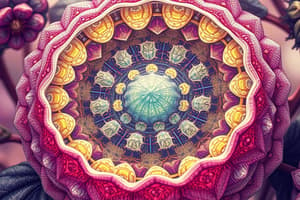Podcast
Questions and Answers
What is a thylakoid?
What is a thylakoid?
- A type of plant cell
- A flattened membrane sac inside the chloroplast (correct)
- An organelle found only in animals
- A type of sugar
What is a granum?
What is a granum?
Stack of thylakoids
What do lamella do?
What do lamella do?
Tubes that connect the granum
What is chloroplast DNA?
What is chloroplast DNA?
What is the role of ribosomes in chloroplasts?
What is the role of ribosomes in chloroplasts?
What are starch granules used for?
What are starch granules used for?
What is the inner membrane of a chloroplast?
What is the inner membrane of a chloroplast?
What is the intermembrane space?
What is the intermembrane space?
What is the outer membrane of a chloroplast?
What is the outer membrane of a chloroplast?
What does the stroma refer to?
What does the stroma refer to?
What occurs in the lumen of thylakoid?
What occurs in the lumen of thylakoid?
What is a chloroplast?
What is a chloroplast?
Flashcards are hidden until you start studying
Study Notes
Chloroplast Structure and Function
- Thylakoids are flattened membrane sacs within chloroplasts, integral for converting light energy into chemical energy during light reactions.
- Granum refers to a stack of thylakoids, efficiently organizing these structures for optimal light absorption.
- Lamella are tubular connections between granum stacks, facilitating the transfer of energy and materials.
Genetic and Protein Synthesis Components
- Chloroplast DNA is a form of non-nuclear DNA, supporting the endosymbiotic theory, which suggests chloroplasts originated from free-living prokaryotes.
- Ribosomes within chloroplasts serve as the site for protein synthesis, crucial for chloroplast function and maintenance.
Storage and Membrane Structure
- Starch granules function as storage units for starch and sugars produced during photosynthesis, providing energy reserves for the plant.
- The inner membrane is the innermost membrane of the chloroplast, containing components essential for its metabolic processes.
- The intermembrane space is the area between the inner and outer membranes, playing a role in the compartmentalization of functions within the chloroplast.
- The outer membrane is the chloroplast's boundary in direct contact with the cytosol of the plant cell, regulating the exchange of materials.
Metabolic Processes
- Stroma is the liquid matrix inside the chloroplast where the Calvin Cycle, also known as dark reactions, occurs; this process converts CO2 into glucose.
- The lumen of the thylakoid is the space inside the thylakoid where light reactions take place, highlighting the structural specialization in chloroplasts for efficient energy conversion.
General Overview
- Chloroplasts are organelles in plant cells and some other organisms, primarily responsible for capturing sunlight and converting it into chemical energy through photosynthesis.
Studying That Suits You
Use AI to generate personalized quizzes and flashcards to suit your learning preferences.




